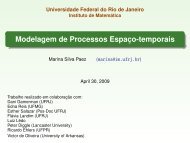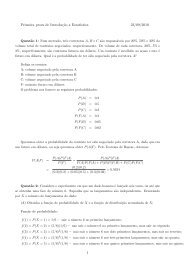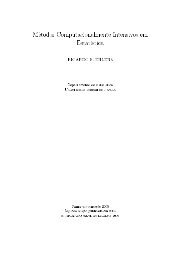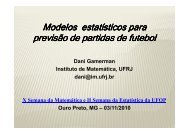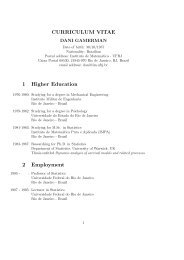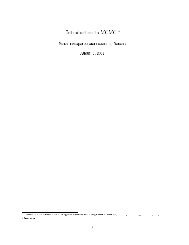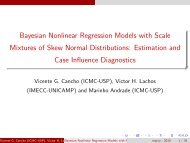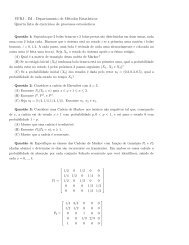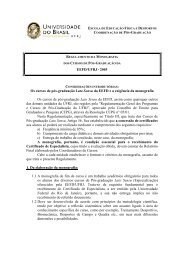Copulas: a Review and Recent Developments (2007)
Copulas: a Review and Recent Developments (2007)
Copulas: a Review and Recent Developments (2007)
You also want an ePaper? Increase the reach of your titles
YUMPU automatically turns print PDFs into web optimized ePapers that Google loves.
Sklar's Theorem (for conditional pseudo copula, Fermanian <strong>and</strong> Wegkamp(2004)). Let H be a joint distribution function on (¡1; 1) n . Assume that for everyx =(x 1 ;::: ;x n ), y =(y 1 ;::: ;y n ) 2 (¡1; 1) n ,F Xi (x i )=F Xi (y i ) for all 1 · j · n implies H(x) =H(y):Then there exist a conditional pseudo-copula C pseudo such thatH(x) =C pseudo (F X1 (x 1 );::: ;F Xn (x n ));for every x =(x 1 ;::: ;x n ) 2 (¡1; 1) n . The function C pseudo is uniquely de¯nedon RanF X1 £ :::£ RanF Xn , the product of the values taken by the F Xi . Conversely,if C pseudo is a conditional pseudo-copula <strong>and</strong> if F X1 ;::: ;F Xn are some univariatedistribution functions, then the function H is an n-dimensional distribution function.¥Note that the conditional pseudo-copula C pseudo in the last theorem is a copulaif <strong>and</strong> only if H(+1;::: ;x i ;::: ;1) = F Xi (x i ) for every i = 1;::: ;n <strong>and</strong> x =(x 1 ;::: ;x n ) 2 (¡1; 1) n .Additional statements <strong>and</strong> estimation of conditional pseudo-copulas as well asapplications to goodness of ¯t test are discussed by Fermanian <strong>and</strong> Wegkamp (2004).Fermanian <strong>and</strong> Scaillet (2005) consider statistical pitfalls arising when using copulas,in particular they discuss issues in copula estimation <strong>and</strong> the design of time-dependentcopulas. They provide a simulation study where it is shown the potential impact ofmisspeci¯ed margins on the estimation of the copula parameter.2.5 An application: using copula to bound quantile measuresConsider a decision maker faced with a number of risks, i.e. r<strong>and</strong>om future losses. Arisk measure à is de¯ned as a mapping from the set of r<strong>and</strong>om variables representingthe risks at h<strong>and</strong> to the real line, i.e., à :(¡1; 1) n ! (¡1; 1). In this section wewill always consider r<strong>and</strong>om variables as losses, i.e. r<strong>and</strong>om payments that have tobe made.As a ¯rst example, consider the p-quantile risk measure, often called VaR (Valueat-Risk)at level p 2 (0; 1), de¯ned byVaR p (X) =inffx 2 (¡1; 1) :F X (x) ¸ pg = F ¡1X(p):For a given risks (X 1 ;::: ;X n )<strong>and</strong>ariskmeasureà :(¡1; 1) n ! (¡1; 1) oneisofteninterestedincomputing certain quantities of Ã(X 1 ;::: ;X n ) like some momentsor a quantile. In the actuarial <strong>and</strong> ¯nance literature can be found variety of formsof such a risk measure à corresponding to exotic options, basket derivatives, creditderivatives, operational risk, insurance covers, see Embrechts et al. (2003a), Georgeset al. (2001), Patton (2006). Typical examples of à include:16



